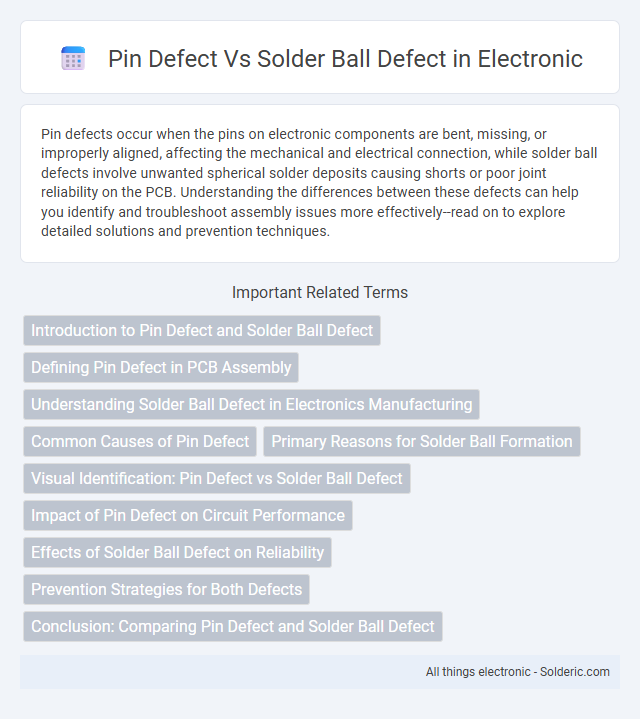Pin defects occur when the pins on electronic components are bent, missing, or improperly aligned, affecting the mechanical and electrical connection, while solder ball defects involve unwanted spherical solder deposits causing shorts or poor joint reliability on the PCB. Understanding the differences between these defects can help you identify and troubleshoot assembly issues more effectively--read on to explore detailed solutions and prevention techniques.
Comparison Table
| Aspect | Pin Defect | Solder Ball Defect |
|---|---|---|
| Definition | Physical damage or misalignment of connector pins | Unwanted solder spheres causing electrical shorts or opens |
| Cause | Mechanical stress, improper insertion, manufacturing error | Excess solder, contamination, improper reflow process |
| Impact | Signal loss, intermittent connection, device failure | Short circuits, open circuits, reduced reliability |
| Detection | Visual inspection, X-ray, continuity testing | X-ray inspection, automated optical inspection (AOI) |
| Repair | Pin straightening, replacement of connector | Removal of solder balls, rework of solder joints |
| Prevention | Proper handling, accurate insertion, quality control | Controlled solder paste application, optimized reflow profile |
Introduction to Pin Defect and Solder Ball Defect
Pin defects involve issues such as bent, broken, or misaligned pins that compromise electrical connectivity in electronic components, often caused by mechanical stress during manufacturing or handling. Solder ball defects refer to unintended, small spheres of solder material that form on the surface of a printed circuit board (PCB) or component leads, potentially causing short circuits or poor solder joints. Both defects critically impact the reliability and performance of electronic assemblies, necessitating precise inspection and quality control measures in semiconductor and PCB manufacturing processes.
Defining Pin Defect in PCB Assembly
Pin defect in PCB assembly refers to the improper alignment, bending, or incomplete insertion of pins on electronic components, resulting in poor electrical connectivity or mechanical failure. This defect contrasts with solder ball defect, which involves unintended spherical solder formations causing shorts or opens on solder joints. Proper pin alignment and placement are critical to ensure reliable circuit performance and minimize rework costs.
Understanding Solder Ball Defect in Electronics Manufacturing
Solder ball defects in electronics manufacturing occur when small, unintended spheres of solder form on the circuit board, potentially causing short circuits and functional failures. These defects often result from improper solder paste application, excessive heat during reflow, or contamination on PCB surfaces. Distinct from pin defects, which involve physical damage or misalignment of component leads, solder ball defects primarily compromise electrical integrity and reliability during device operation.
Common Causes of Pin Defect
Pin defects commonly arise from improper alignment during component placement, soldering temperature variations, and mechanical stress during handling or assembly. Contaminants such as dust or flux residues on pins can lead to poor electrical connections and increased failure rates. Consistent quality control and precise automated placement mechanisms help reduce pin defect occurrences in electronic manufacturing.
Primary Reasons for Solder Ball Formation
Solder ball defects primarily occur due to improper solder paste printing, such as excessive paste volume or misalignment, leading to excess solder residue on the PCB. Contaminants on the board surfaces or oxidation of solder paste components further contribute to solder ball formation by preventing proper wetting during reflow. Variations in reflow profile, including insufficient temperature or rapid cooling, also cause incomplete solder joint formation, resulting in small, detached solder balls.
Visual Identification: Pin Defect vs Solder Ball Defect
Pin defects typically present as bent, missing, or misaligned pins on electronic components, easily identifiable through irregular shapes or gaps during visual inspection. Solder ball defects appear as small, spherical metal balls often found around solder joints or on the PCB surface, caused by excess solder or contamination. High-magnification imaging and consistent lighting conditions are crucial for accurately distinguishing between these two defect types.
Impact of Pin Defect on Circuit Performance
Pin defects can cause intermittent or permanent open circuits, leading to signal loss, increased resistance, and unreliable electrical connections that degrade overall circuit performance. Unlike solder ball defects, which primarily affect mechanical stability and can cause short circuits, pin defects directly disrupt the intended current paths and data integrity in high-frequency or precision applications. Your system's reliability heavily depends on pin integrity, making early detection and correction critical to prevent failure in critical electronic devices.
Effects of Solder Ball Defect on Reliability
Solder ball defects can lead to intermittent electrical connectivity and increased resistance, significantly compromising your device's reliability. These tiny solder irregularities may cause signal integrity issues, thermal stress, and eventual failure in electronic assemblies. Ensuring proper solder ball formation is crucial to maintain consistent performance and prevent costly device malfunctions.
Prevention Strategies for Both Defects
Effective prevention strategies for pin defects and solder ball defects revolve around meticulous process control and material quality management. For pin defects, ensuring precise alignment during component placement and using high-quality pins with robust mechanical properties reduces damage risks. In solder ball defect prevention, optimizing solder paste volume, refining reflow profiles, and maintaining clean surfaces are critical to achieving consistent solder joint formation and avoiding bridging or insufficient solder.
Conclusion: Comparing Pin Defect and Solder Ball Defect
Pin defects typically cause connection failures due to bent or misaligned pins, impacting mechanical reliability and signal integrity. Solder ball defects often lead to electrical shorts or open circuits, posing risks to circuit functionality and long-term device performance. Understanding the distinct failure mechanisms helps you prioritize inspection and corrective measures tailored to either pin or solder ball defects for improved manufacturing yields.
Pin defect vs solder ball defect Infographic

 solderic.com
solderic.com